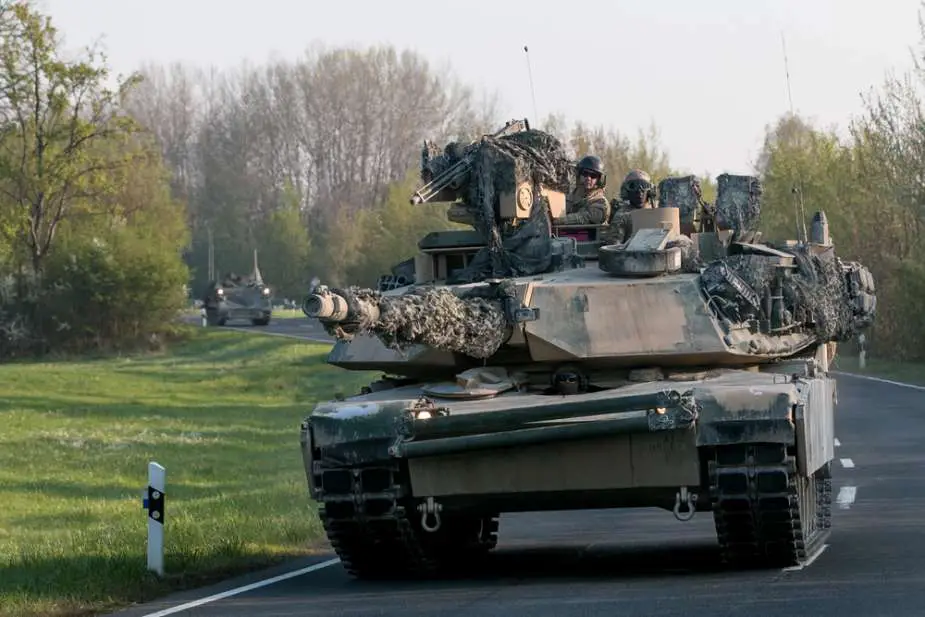China evaluates hypervelocity kinetic weapons against US tanks
To assess the effectiveness of hypervelocity kinetic weapons against the armor of American tanks, Chinese researchers have conducted tests, drawing inspiration from the ongoing conflict in Ukraine and paying particular attention to the armored divisions of Taiwan equipped by the United States.
Follow Army Recognition on Google News at this link

M1A2 Abrams tank conducting a tactical road march (Picture source: US DoD)
The South China Morning Post (SCMP) revealed that Chinese scientists have performed simulations to evaluate the damage potential of kinetic energy projectiles against American military armor. According to the SCMP, a solid spherical projectile weighing 20 kilograms and traveling at four times the speed of sound could cause significant damage to tanks. The kinetic energy of the projectile is estimated at 25 megajoules, equivalent to less than seven kilowatt-hours in electrical energy terms. Despite external visual integrity, the simulations have revealed substantial internal damage to the targeted tanks.
The study, led by Huang Jie from the Hypervelocity Aerodynamics Institute of China's Aerodynamics Research and Development Center, was published in the peer-reviewed journal Equipment Environmental Engineering. The research highlighted that certain sections of the armored target are highly likely to fail due to overload damage, as indicated by their impact response spectrum lines exceeding the safety limits of the NATO MIL-STD-810 standard. This standard pertains to environmental design and test limits for the lifecycle of military equipment.
The SCMP report further notes that assessing damage caused by kinetic projectiles is more challenging than conventional anti-armor rounds due to the complex manner in which the resulting shock wave travels through the entire vehicle, concentrating stress in areas like bolts, leading to distortion or fracture.
Developing specialized anti-tank weapons, such as the previously mentioned hypervelocity projectiles, is certainly not new in military history. The evolution of anti-tank weapons has been a constant response to advances in tank design and protection.
From the First World War, with the emergence of the first tanks, armies began seeking effective means to neutralize them. This search led to the introduction of the first anti-tank weapons during and after the First World War, including specially designed cannons, mines, and later, anti-tank rifles.
During the Second World War, the arms race intensified with the development of increasingly armored and powerful tanks. In response, more advanced anti-tank weapons were created, such as rocket launchers (e.g., the Panzerfaust and Bazooka) and hollow charges, capable of penetrating thick armor.
After the Second World War, with the rise of main battle tanks, the focus shifted to developing guided anti-tank missiles and other technologies such as kinetic energy munitions and tandem charges to overcome reactive and composite armors.
In recent conflicts, we have seen examples of innovative anti-tank technologies, including precision-guided missiles but especially armed drones which have completely revolutionized modern conflict.
The hypervelocity projectiles studied by the Chinese researchers thus represent a step in this continuous evolution. They offer a new approach to defeating modern armor with their extremely high speed and ability to generate enormous amounts of kinetic energy, potentially neutralizing even the most sophisticated defense systems.
This constant innovation in anti-tank weapons underscores the dynamic nature of military technology, where the development of new offensive methods almost always follows each advancement in defensive armaments to overcome them.
Despite the potential of railgun technology to achieve such high velocities, its practical application remains limited due to technical challenges. However, the SCMP's December 2023 report indicates that China may be progressing in this area, with Chinese engineers developing a railgun capable of firing multiple rounds without damage, assisted by an AI diagnostic system.
- Hits: 2510
















